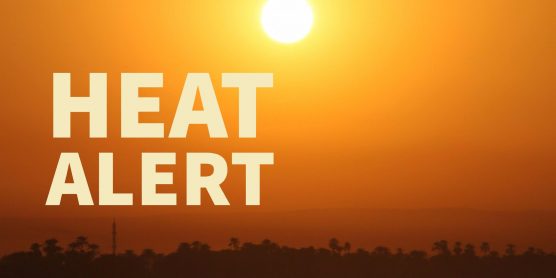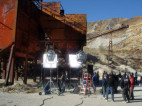The Los Angeles County Health Officer has issued a Heat Alert as high temperatures have been forecast for the areas in Southern California, including the Santa Clarita Valley.
The areas affected are:
Antelope Valley from Saturday, June 17, to Tuesday, June 20.
Additionally, a heat advisory is in effect for the following areas:
Pomona area, San Fernando Valley, and Santa Clarita Valley from Monday, June 19 to Tuesday, June 20
San Gabriel Valley for Tuesday, June 20
The Department of Public Health would like to remind everyone that precautions should be taken, especially by individuals who participate in outdoor activities, older adults, caretakers of infants and children, and those sensitive to the heat. This alert may be extended if weather conditions do not improve.
“When temperatures are high, even a few hours of exertion may cause severe dehydration, heat cramps, heat exhaustion and heat stroke. Others who are frail or have chronic health conditions may develop serious health problems leading to death if they are exposed to high temperatures over several days,” said Jeffrey Gunzenhauser, MD, MPH, Interim Health Officer, Los Angeles County. “Thus, it is critically important to never leave children, elderly people, or pets unattended in homes with no air conditioning and particularly in vehicles, even if the windows are ‘cracked’ or open, as temperatures inside can quickly rise to life-threatening levels. If you have an elderly or infirm neighbor without air conditioning, make sure that they get to a cooling center or other air conditioned space between the hours of 10:00 a.m. and 8:00 p.m.”
For a list of Cooling Centers and information on heat-related illnesses and prevention, please visit the Public Health website at www.publichealth.lacounty.gov, or call 2-1-1. To locate the nearest cooling center, go to http://bit.ly/BeatTheHeat17. Call your local Cooling Center for hours of operation.
“While it is very important that everyone take special care of themselves, it is equally important that we reach out to those who are especially vulnerable to the harmful effects of extreme heat, including children, the elderly, and their pets,” said Dr. Gunzenhauser. “Extreme heat such as this is not just an inconvenience, it can be dangerous and even deadly, but we can protect ourselves, our families, and our neighbors if we take steps to remain cool and hydrated.”
Schools, day camps, and non-school related sports organizations or athletes should take extra precautions during extreme heat. Practices and other outdoor activities should be scheduled for very early or very late in the day in order to limit the amount of time spent in the sun and heat.
Additional tips for those who must work or exercise outdoors:
Ensure that cool drinking water is available.
Drink water or electrolyte-replacing sports drinks often; do not wait until you are thirsty.
Avoid drinking sweetened drinks, caffeine, and alcohol.
Avoid drinking extremely cold water as this is more likely to cause cramps.
Allow athletes or outdoor workers to take frequent rests.
Pay attention to signs of dehydration which include dizziness, fatigue, faintness, headaches, muscle cramps, and increased thirst. Individuals with these symptoms should be moved to a cooler, shaded place, and given water or sport drinks. More severe signs of heat- related illness may include diminished judgment, disorientation, pale and clammy skin, a rapid and weak pulse, and/or fast and shallow breathing.
Coaches, teachers, and employers should seek immediate medical attention for those exhibiting signs of heat-related illness.
Avoid unnecessary exertion, such as vigorous exercise during peak sun hours, if you are outside or in a non-air conditioned building.
Older adults and individuals with chronic medical conditions:
During peak heat hours stay in an air-conditioned area. If you do not have access to air conditioning in your home, visit public facilities such as cooling centers, shopping malls, parks, and libraries to stay cool.
Do not rely only on open windows or a fan as a primary way to stay cool. Use the air conditioner. If you’re on reduced income, find out more about the Low Income Home Energy Assistance Program, by calling (866) 675-6623 or contacting your utility provider.
Older adults and those on certain medications may not exhibit signs of dehydration until several hours after dehydration sets in. Stay hydrated by frequently drinking cool water. If you’re on a special diet that limits liquids, check with your doctor for information on the amount of water to consume.
Stay out of the sun if you do not need to be in it. When in the sun, wear a hat, preferably with a wide brim, and loose-fitting, light-colored clothing with long sleeves and pants to protect against sun damage. And remember to use sun screen and to wear sunglasses.
Infants and Children:
It is illegal to leave an infant or child unattended in a vehicle (California Vehicle Code Section 15620).
Infants and young children can get dehydrated very quickly. Make sure they are given plenty of cool water to drink.
Keep children indoors or shaded as much as possible.
Dress children in loose, lightweight, and light colored clothing.
Pets:
Never leave a pet unattended in a vehicle, even with the windows ‘cracked’ or open.
Outdoor animals should be given plenty of shade and clean drinking water.
Do not leave pets outside in the sun.
Pets should not be left in a garage as garages can get very hot due to lack of ventilation and insulation.
Heat-Related Illnesses
Heat Cramps:
Symptoms include muscular pains and spasms, usually in the stomach, arms or leg muscles.
Heat cramps usually result from heavy exertion, such as exercise, during extreme heat.
Although heat cramps are the least severe of all heat-related problems, they are usually the first signal that the body is having trouble coping with hot temperatures. Heat cramps should be treated immediately with rest, fluids and getting out of the heat.
Seek medical attention if pain is severe or nausea occurs.
Heat Exhaustion:
Symptoms include heavy sweating, pale and clammy moist skin, extreme weakness or fatigue, muscle cramps, headache, dizziness or confusion, nausea or vomiting, fast and shallow breathing, or fainting.
First Aid: Heat exhaustion should be treated immediately with rest in a cool area, sipping water or a sports drink, applying cool and wet cloths and elevating the feet 12 inches.
If left untreated, victims may go into heat stroke.
Seek medical attention if the person does not respond to the above, basic treatment.
Heat Stroke:
Symptoms include flushed, hot, moist skin or a lack of sweat, high body temperature (above 103ºF), confusion or dizziness, possible unconsciousness, throbbing headache, rapid, or strong pulse.
Heat stroke is the most severe heat-related illness and occurs when a person’s temperature control system, which produces sweat, stops working.
Heat stroke may lead to brain damage and death.
First Aid: Call 911. Move victim to a cool shaded area. Fan the body, and spray body with water.
Los Angeles County residents and business owners, including people with disabilities and others with access and functional needs may also call 2-1-1 for emergency preparedness information and other referral services. The toll-free 2-1-1 number is available 24 hours a day, seven days a week. 211 LA County services can also be accessed by visiting www.211la.org.
About Los Angeles County Department of Public Health
The Los Angeles County Department of Public Health is committed to protecting and improving the health of over 10 million residents of Los Angeles County. Through a variety of programs, community partnerships and services, Public Health oversees environmental health, disease control, and community and family health. Nationally accredited by the Public Health Accreditation Board, the Los Angeles County Department of Public Health comprises nearly 4,000 employees and has an annual budget exceeding $900 million. To learn more about the Department of Public Health and the work we do, please visit PublicHealth.LACounty.gov.
Like this:
Like Loading...
Related





 Tweet This
Tweet This Facebook
Facebook Digg This
Digg This Bookmark
Bookmark Stumble
Stumble RSS
RSS


























REAL NAMES ONLY: All posters must use their real individual or business name. This applies equally to Twitter account holders who use a nickname.
0 Comments
You can be the first one to leave a comment.